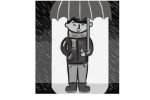Many Oregonians tend to miss the sun throughout the winter months and begin to feel a bit blue as it gets dark early in the day. There’s also a portion of Oregonians who experience an even deeper depression that goes beyond feeling blue when it’s cold and dark outside.
Seasonal Affective Disorder affects about 10 percent of the general population, and people living in areas with dark or cold winters, such as Oregon and Washington, are especially prone to developing SAD. Seasonal Affective Disorder tends to occur during the same time every year throughout the winter months, differentiating from other disorders such as year-round depression.
Though not everyone with SAD experiences the same symptoms, some common symptoms may include fatigue, a change in appetite, weight gain, a heavy feeling in the arms or legs, irritability, difficulty concentrating, a tendency to oversleep, and an avoidance of social situations. You may also experience symptoms of depression such as guilt, a loss of interest in activities you used to enjoy, feeling hopeless or helpless, and physical problems such as headaches and stomach issues.
When feeling depressed, it’s often hard to believe that anything will pull you out of your own head. It may also be hard to believe anything can make you feel even a little better. However, there are some things that may help:
1.) Light therapy boxes or a dawn simulator.
Both of these are great tools for people experiencing SAD because they simulate natural light. They have been shown to improve your mood overall. They work most effectively in treating SAD when used within the first hour of waking up for about 30 minutes.
2.) Exercise, or simply going for a walk.
Light exercise has been proven to release endorphins, which are chemicals in your brain that improve your mood.
3.) Talk with your doctor or a certified mental health professional.
These are the experts that can diagnose you if you feel like you may have SAD. These professionals may know a therapist that you can talk to or the proper treatment to help you.
4.) Aromatherapy.
5.) Vitamin D.
Taking Vitamin D supplements may be able to replace the vitamins you normally receive from sunshine when the sunlight remains absent in the the dark winter months.
6.) Spend time with family and friends.
7.) Consider antidepressants.
There is nothing shameful about taking antidepressants. If you think having a prescription for an antidepressant would help you, talk with your doctor or a mental health professional.
8.) Focus on personal care.
Take a nice bath, get enough sleep, keep a journal for self-reflection, treat yourself, watch a favorite movie or television show, and focus on your personal needs.
9.) Keep warm.
Drink and eat warm foods. Make sure to wear warm clothes and shoes so you don’t feel cold when you go outside. Try to keep your home between 64–70 degrees Fahrenheit.
10.) Eat healthy.
Having a healthy diet and eating well cannot be understated. A healthy diet will boost your mood, give you more energy, and keep you healthy throughout the winter months. A healthy diet is a balanced diet of fruits and vegetables, carbohydrates, and protein. Still, don’t forget to treat yourself! Chocolate may be just the thing you need to feel better, and that’s okay.
The holidays and dark, cold winter months can be hard, but if it turns into something more, it’s important to take care of yourself. If you’re not able to take care of yourself or need help in doing so, please talk with someone. There is no shame in admitting you need help or in asking for it.
